Lectures: 79 Conferences and talks
The ruins of Palmyra by Hazel Dogde
27 October 2015 5:00 pm at SAUL Studio
The recent violent destruction of the ancient city of palmyra in Syria is an assault on the very idea of civilisation. The theme of this lecture is architecture’s power to express cultural values and unite disparate believes. Through architecture we establish a common ground for appreciating past achievements and building a shared future. This is discussed against the background of a changing political landscape, recurrent conflicts, destruction and re-building with the ancient city of Palmyra as the focal point.
Hazel Dogde is the Louis Claude Purser Associate Professor in Classical Archaeology at Trinity College Dublin. With degrees from the University of Newcastle upon Tyne she previously held a fellowship of the British Academy at the University of Oxford. In 2010–11 she was Samuel H. Kress Lecturer of the Archaeological Institute of America, of which she is also a Corresponding Member. In 2013 she held the Frederic Lindley Morgan Visiting Chair in Architectural Design at the University of Louisville, Kentucky. Her research expertise is three-fold: Roman construction and building technology, ancient spectacle and buildings for entertainment, and urbanisation in the ancient world, particularly the development of the City of Rome.
“Futures of the past” looks at buildings of the past and how we think about their future. Aware of the necessarily creative and destructive role of architecture we hold a deep interest in what exists.
These series of talks are a public forum intended to address a range of questions on role, past and present.
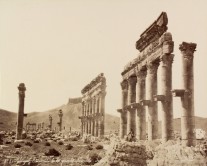
Curating the city by Hugh Maguire and Michael O’Connor
20 October 2015 5:30 pm at Fab Lab Limerick
Under the current Development Plan is scheduled for demolition. Why shouldn’t it be? A museum curator and a practicing architect debate the value of Modern architecture: Why and how should a generic concrete structure be spared and adapted for new uses? Beyond individual buildings, ideas of collecting, preserving and curating the city for future generations will be discussed.
Hugh Maguire is now one of the longest serving directors of the Hunt Museum, having joined the Museum in late 2009. Before that, he was the Museums and Archives Officer in The Heritage Council. A graduate of Trinity College, Dublin and the Courtauld Institute of Art, London he previously held numerous lecturing and publishing positions in Ireland and overseas. In addition to the day-to-day administration of the museum as its director, together with the Board, Hugh accounts for strategic directions as well as being the public face of the museum.
Michael O’Connor is an architect in private practice in Limerick and London, as O’Connor + Shanahan for public work contracts and some corporate clients and as ‘praxis architecture’ for private commissions. A graduate of UCD and member of the RIAI, Michael is also a registered Conservation Architect both in Ireland and the UK. Parallel to his work in practice Michael has undertaken extensive research on viable ways to adapt Sarsfield House to future uses. ‘Praxis architecture’ was commended at the 2015 RIAI Awards for Best Emerging Practice.
“Futures of the past” looks at buildings of the past and how we think about their future. Aware of the necessarily creative and destructive role of architecture we hold a deep interest in what exists. This series of talks is a public forum intended to address a range of questions on architecture’s role, past and present.
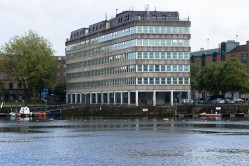
Dialectics of creation and destruction by Kieran Keohane, introduced by Tom Moylan
29 September 2015 5:00 pm at SAUL Studio
“Our concern is about how the past plays itself out in the present, and how past and present recur into the future. If ‘imagination is working over the remembered,’ as James Joyce says, we are interested also in what one might call ‘memories of the future’.”
Kieran Keohane is Senior Lecturer in Sociology at UCC’s School of Sociology and Philosophy, recognised as a Teaching Hero by his students. His current work covers areas such as urban culture, the generation and legacy of cultural capital and the cultivation of cosmopolitanism. Kieran Keohane published “Collision Culture” (2004) on transformations in everyday life in Ireland and “Cosmopolitan Ireland” (2007) on globalisation and quality of life, both together with UL sociologist Carmen Kuhling.
“Futures of the past” looks at buildings of the past and how we think about their future. Aware of the necessarily creative and destructive role of architecture we hold a deep interest in what exists. This series of talks is a public forum intended to address a range of questions on architecture’s role, past and present.
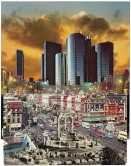
Life, death and resurrection by Shane O’Toole, introduced by Elizabeth Hatz
22 September 2015 5:00 pm at SAUL Studio
“Mies’ work stands proud – and still relevant. His work, even today, is a yardstick to measure our understanding of Modern architecture.”
Shane O’Toole is an architect, historian, author, editor, curator, broadcaster and campaigner for threatened buildings. He was one of the founding directors of Group 91Architects. He guided the framework plan for the regeneration of Dublin’s Temple Bar district during the 1990s, work that has been honoured with several awards. He commissioned and curated highly acclaimed national and international architecture exhibitions. Since 2012, Shane has been a member of the Expert Committee for the European Prize for Urban Public Space. He is recognised for his regular contributions in The Sunday Times and Building Design.
“Futures of the past” looks at buildings of the past and how we think about their future. Aware of the necessarily creative and destructive role of architecture we hold a deep interest in what exists. This series of talks is a public forum intended to address a range of questions on architecture’s role, past and present.
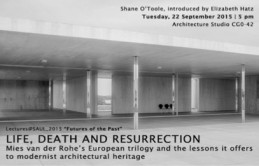
Talking to my father by Sé Merry Doyle and Simon Walker
15 September 2015 5:00 pm at SAUL Studio
“Talking to my Father” features two voices from two eras each concerned with how we as a nation understand the architecture that surrounds our lives. Modern architecture in Ireland reached a high point in the early sixties and one of its most celebrated and influential figures was Robin Walker. Robin Walker studied under Le Corbusier in Paris as a young graduate and later worked alongside Mies van der Rohe in Chicago. His return to Ireland in 1958 coincided with the emergence of an aspiring modern nation recovering from years of stagnation and emigration. Robin Walker became a key agent in this nation-building process. “Sé Merry Doyle’s documentary follows Simon on his journey back through his own life and relationship with his father, Robin Walker.
Robin was a remarkably talented and prolific figure in the reformation of Ireland’s architecture in what was an emerging, modern nation. Simon, also an architect, traces his memory with his father’s architecture as his guide, travelling Ireland from building to building, conversing with each across what Robin Walker understood to be a breathtakingly beautiful landscape, recognised in his work. The documentary is in large part about that – the relationship we have with our environment and how architecture, particularly that of Robin Walker, contributes to that relationship.”
“Sé Merry Doyle’s documentary follows Simon on his journey back through his own life and relationship with his father, Robin Walker. Robin was a remarkably talented and prolific figure in the reformation of Ireland’s architecture in what was an emerging, modern nation. Simon, also an architect, traces his memory with his father’s architecture as his guide, travelling Ireland from building to building, conversing with each across what Robin Walker understood to be a breathtakingly beautiful landscape, recognised in his work. The documentary is in large part about that – the relationship we have with our environment and how architecture, particularly that of Robin Walker, contributes to that relationship.”
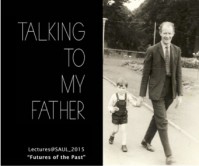
The New Ways We Build by Bruce Bell
23 April 2015 6:30 pm at SAUL Studio
THE NEW WAYS WE BUILD
A talk about the impact of digital of digital fabrication in design with the support of Irish Design 2015. April 23rd 18:30 at Fab Lab Limerick 
Digital fabrication has been used for rapid prototyping in the manufacturing industry for more than two decades now. New open source designs for 3D printers, laser cutters and CNC machines have dramatically lowered the entry cost for these technologies making them accessible to all sorts of creative disciplines. Designers, craftspersons and architects are using digital fabrication to redefine design at its very core, from new professional roles, to alternatives to mass manufacturing and traditional consumption models.
Facit Homes is one of the first companies in the world to digitally fabricate and manufacture an entire house on-site. The company’s patented D-Process uses a compact, high-tech machine to turn a 3D computer model into exact physical components that can be snapped together like LEGO bricks. Facit Homes’ D- Process was shortlisted as one of 60 finalists for the 2013 Index: Award.
This event has free admission and no previous reservation is required. The talk will be introduced by Javier Burón, Fab Lab Limerick Director.
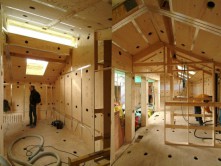
From the individual to the collective by Santiago Cirugeda
14 April 2015 6:30 pm at Fab Lab Limerick
Santiago Cirugeda is the personification of ‘guerrilla architecture’ and set up the collective Recetas Urbanas which translates as Recipes for the City – to empower other citizens to find loopholes in planning laws to adapt and create their environments.
He has developed a series of subversive projects that explore the complexities of urban life, including the occupation of public spaces and containers; building prostheses into façades, patios and empty lots; and negotiating a way between legal and illegal zones.
Cirugeda has built housing units on rooftops, classrooms on top of a variety of institutions, and civic centres constructed from materials collected from about-to-be demolished buildings. His website details how ‘habitable scaffoldings’ can be attached to the facades of existing buildings, and other dwellings built entirely from waste materials.
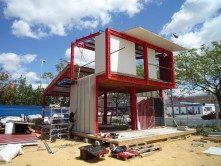
Time in the Novel by Kim Stanley Robinson
7 April 2015 5:30 pm at SAUL Studio
SAUL (School of Architecture University of Limerick) and The Ralahine Centre for Utopian Studies UL are proud to welcome one of the most renowned writers of science fiction, Kim Stanley Robinson, to SAUL on 7th April where he will present a lecture entitled “Time in the Novel”. The opening welcome will be made by SAUL Professor Merritt Bucholz followed by an official greeting by Professor Don Barry, President, UL. Professor Emeritus Tom Moylan will then make an introduction.
This SAUL public lecture is free but registration is required beforehand at the following link.
This lecture forms part of ‘A Week With Kim Stanley Robinson’ from 6th-10th April, a unique, interdisciplinary series of events including readings, workshops, lectures, conversations, and site visits, many of which are free to the public (details attached).
Kim Stanley Robinson is a towering, multi-award-winning figure in science fiction, and he has authored over 20 books, including the Mars trilogy(1993-1997) and Aurora(2015). His work deals with some of the most critical social, economic, and environmental issues facing our world, particularly in relation to ecological sustainability, world building, and utopian possibilities. Robinson’s writing resonates with the ethos of the Ralahine Centre for Utopian Studies, which was established in 2003 with a research agenda based on the premise that social values, policies, and practices are shaped by hopeful, utopian visions which is critical to the betterment of life for all members of society.
As Founding Director of the Ralahine Centre for Utopian Studies, which is named after the nineteenth century Ralahine Cooperative in Newmarket-on-Fergus, Professor Emeritus Tom Moylan notes that Robinson’s visit to Limerick and Tipperary marks “a significant moment in the Centre’s twelve-year history of conducting research, teaching, and public programmes on all topics of utopian studies.” Moylan continues, “Kim Stanley Robinson’s work entertains and challenges readers of all generations. Unafraid of writing critical accounts of the world as it is, he is no less afraid of generating realistic future alternatives. Whether in near-future science fiction dealing with rapid climate change or more far-reaching accounts of the settlement of Mars or stories about prehistory or time travel to the future, Robinson is simply one of the best. We are privileged here at UL to have him with us as our guest for a week.”
Short Biography:
Kim Stanley Robinson is a New York Times bestseller and winner of the Hugo, Nebula, and Locus awards. He is the author of more than twenty books, including the bestselling Mars trilogy and the critically acclaimed Forty Signs of Rain, The Years of Rice and Salt and 2312. In 2008, he was named a “Hero of the Environment” by Time magazine, and he works with the Sierra Nevada Research Institute. He lives in Davis, California.
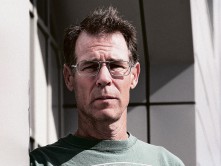
The new ways we make. Diatom Studio by Greg Saul in conversation with Leo Scarff
25 March 2015 6:00 pm at Fab Lab Limerick
The new ways we make is a talk series organized by Fab Lab Limerick with the support of Irish Design 2015 about the impact of digital fabrication in design. Digital fabrication have been used for rapid prototyping in the manufacturing industry for more than two decades now. New open source designs for 3D printers, laser cutters and CNC machines have dramatically lowered the entry cost for these technologies making them accessible to all short of creative disciplines. Designers, craftspersons and architects are using digital fabrication to redefine design at its very core, from new professional roles, to alternatives to mass manufacturing and traditional consumption models.
Greg Saul, Diatom Studio http://diatom.cc & http://sketchchair.cc London, United Kingdom. Greg is a designer, programmer, maker who is interested in challenging the roles of the consumer and designer through his work. Diatom.cc is his independent design and invention practice based in London in which he explores the possibilities that digital tools offer to give the end user a role in the design process.
Leo Scarff http://www.leoscarffdesign.com Leitrim, Ireland. Leo is a product designer, design lecturer, consultant and exhibition curator originally from Dublin now based in Manorhamilton, County Leitrim. He has over 20 year experience in the design world, having set up his design studio in 1997 and has lectured on product design and design history since 1999. Currently he is working on setting up a Fab Lab in Manorhamilton with three other collaborators.
The talk will be moderated by Javier Burón, Fab Lab Limerick Director.
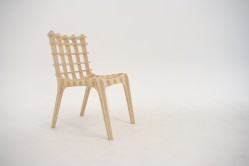
Strategies and Tactics by Kazys Varnelis
4 March 2015 5:30 pm at SAUL Studio
BIOGRAPHY: Kazys Varnelis is a lecturer at the School of Architecture, University of Limerick and also teaches at Columbia University and Massachusetts Institute of Technology. He is the Director of the Network Architecture Lab and co-founder of the conceptual architecture/media group AUDC. He has exhibited widely in places such as High Desert Test Sites, the New Museum, and the Museum of Modern Art. He is co-author of Blue Monday: Absurd Realities and Natural Histories, editor of the Infrastructural City. Networked Ecologies in Los Angeles, Networked Publics and The Philip Johnson Tapes: Interviews with Robert A. M. Stern, all published in 2008. He received his Ph.D. in the history of architecture and urban development from Cornell University in 1994, where he completed his dissertation on the role of the spectacle in the production of form and persona in the architecture of the 1970s.

